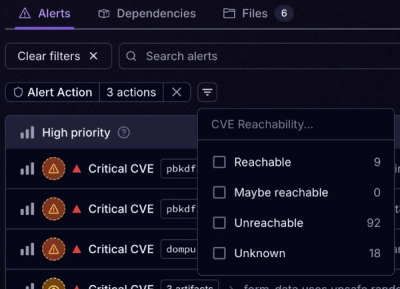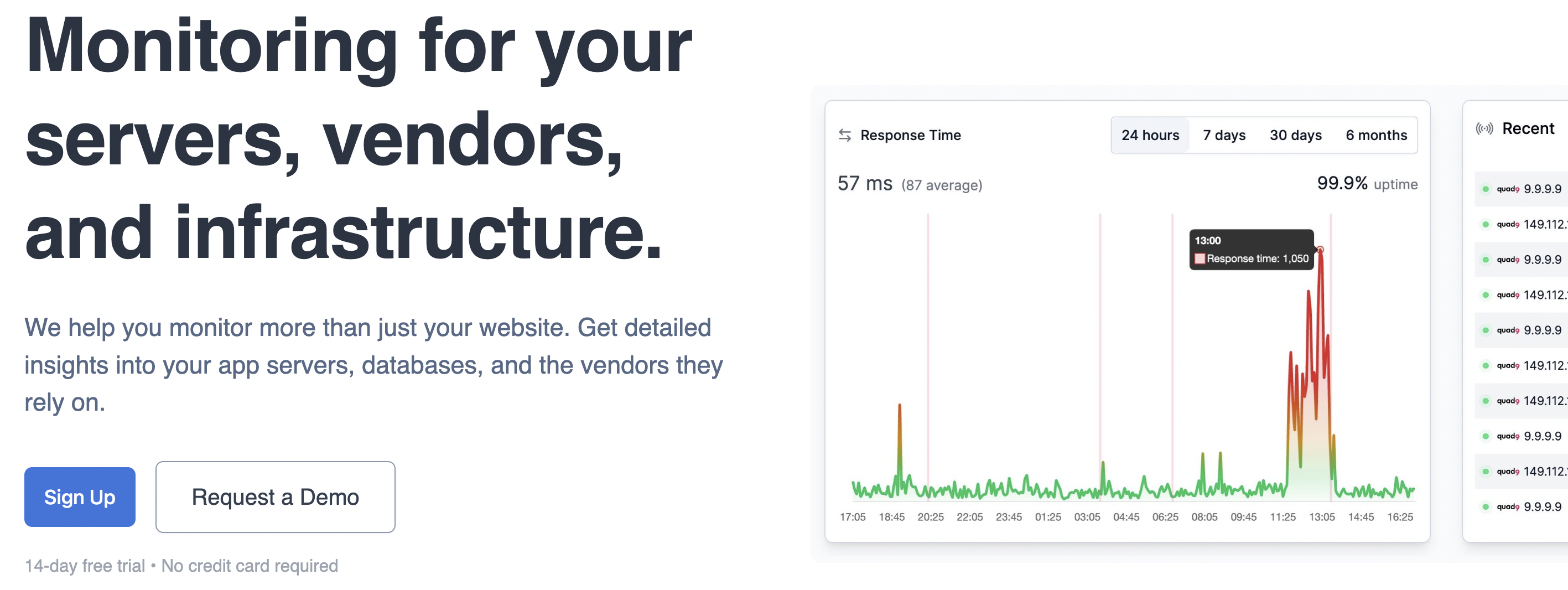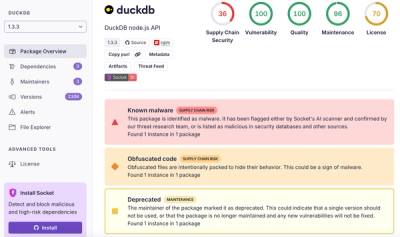
Product
Introducing Tier 1 Reachability: Precision CVE Triage for Enterprise Teams
Socket’s new Tier 1 Reachability filters out up to 80% of irrelevant CVEs, so security teams can focus on the vulnerabilities that matter.

Short answer, we probably don't. Camo was created for two reasons: to bring traditional-style classes to MongoDB JavaScript, and to support NeDB as a backend (which is much like the SQLite-alternative to Mongo).
Throughout development this eventually turned in to a library full of ES6 features. Coming from a Java background, its easier for me to design and write code in terms of classes, and I suspect this is true for many JavaScript beginners. While ES6 classes don't bring any new functionality to the language, they certainly do make it much easier to jump in to OOP with JavaScript, which is reason enough to warrent a new library, IMO.
So, why use Camo?
promisify-ing your ODM or waiting for Promise support to be added natively.* Support coming soon.
To use Camo, you must first have installed Node >2.0.x, then run the following commands:
npm install camo --save
And at least ONE of the following:
npm install nedb --save
OR
npm install mongodb --save
Camo was built with ease-of-use and ES6 in mind, so you might notice it has more of an OOP feel to it than many existing libraries and ODMs. Don't worry, focusing on object-oriented design doesn't mean we forgot about functional techniques or asynchronous programming. Promises are built-in to the API. Just about every call you make interacting with the database (find, save, delete, etc) will return a Promise. No more callback hell :)
For a short tutorial on using Camo, check out this article.
Before using any document methods, you must first connect to your underlying database. All supported databases have their own unique URI string used for connecting. The URI string usually describes the network location or file location of the database. However, some databases support more than just network or file locations. NeDB, for example, supports storing data in-memory, which can be specified to Camo via nedb://memory. See below for details:
var uri = 'mongodb://scott:abc123@localhost:27017/animals';var uri = 'nedb:///Users/scott/data/animals';So to connect to an NeDB database, use the following:
var connect = require('camo').connect;
var database;
var uri = 'nedb:///Users/scott/data/animals';
connect(uri).then(function(db) {
database = db;
});
All models must inherit from the Document class, which handles much of the interface to your backend NoSQL database.
var Document = require('camo').Document;
class Company extends Document {
constructor() {
super();
this.name = String;
this.valuation = {
type: Number,
default: 10000000000,
min: 0
};
this.employees = [String];
this.dateFounded = {
type: Date,
default: Date.now
};
}
static collectionName() {
return 'companies';
}
}
Notice how the schema is declared right in the constructor as member variables. All public member variables (variables that don't start with an underscore [_]) are added to the schema.
The name of the collection can be set by overriding the static collectionName() method, which should return the desired collection name as a string. If one isn't given, then Camo uses the name of the class and naively appends an 's' to the end to make it plural.
Schemas can also be defined using the this.schema() method. For example, in the constructor() method you could use:
this.schema({
name: String,
valuation: {
type: Number,
default: 10000000000,
min: 0
},
employees: [String],
dateFounded: {
type: Date,
default: Date.now
}
});
Currently supported variable types are:
StringNumberBooleanBufferDateObjectArrayEmbeddedDocumentArrays can either be declared as either un-typed (using Array or []), or typed (using the [TYPE] syntax, like [String]). Typed arrays are enforced by Camo on .save() and an Error will be thrown if a value of the wrong type is saved in the array. Arrays of references are also supported.
To declare a member variable in the schema, either directly assign it one of the types listed above, or assign it an object with options, like this:
this.primeNumber = {
type: Number,
default: 2,
min: 0,
max: 25,
choices: [2, 3, 5, 7, 11, 13, 17, 19, 23],
unique: true
}
The default option supports both values and no-argument functions (like Date.now). Currently the supported options/validators are:
type: The value's type (required)default: The value to be assigned if none is provided (optional)min: The minimum value a Number can be (optional)max: The maximum value a Number can be (optional)choices: A list of possible values (optional)match: A regex string that should match the value (optional)validate: A 1-argument function that returns false if the value is invalid (optional)unique: A boolean value indicating if a 'unique' index should be set (optional)required: A boolean value indicating if a key value is required (optional)To reference another document, just use its class name as the type.
class Dog extends Document {
constructor() {
super();
this.name = String;
this.breed = String;
}
}
class Person extends Document {
constructor() {
super();
this.pet = Dog;
this.name = String;
this.age = String;
}
static collectionName() {
return 'people';
}
}
Embedded documents can also be used within Documents. You must declare them separately from the main Document that it is being used in. EmbeddedDocuments are good for when you need an Object, but also need enforced schemas, validation, defaults, hooks, and member functions. All of the options (type, default, min, etc) mentioned above work on EmbeddedDocuments as well.
var Document = require('camo').Document;
var EmbeddedDocument = require('camo').EmbeddedDocument;
class Money extends EmbeddedDocument {
constructor() {
super();
this.value = {
type: Number,
choices: [1, 5, 10, 20, 50, 100]
};
this.currency = {
type: String,
default: 'usd'
}
}
}
class Wallet extends Document {
constructor() {
super();
this.contents = [Money];
}
}
var wallet = Wallet.create();
wallet.contents.push(Money.create());
wallet.contents[0].value = 5;
wallet.contents.push(Money.create());
wallet.contents[1].value = 100;
wallet.save().then(function() {
console.log('Both Wallet and Money objects were saved!');
});
To create a new instance of our document, we need to use the .create() method, which handles all of the construction for us.
var lassie = Dog.create({
name: 'Lassie',
breed: 'Collie'
});
lassie.save().then(function(l) {
console.log(l._id);
});
Once a document is saved, it will automatically be assigned a unique identifier by the backend database. This ID can be accessed by the ._id property.
If you specified a default value (or function) for a schema variable, that value will be assigned on creation of the object.
An alternative to .save() is .findOneAndUpdate(query, update, options). This static method will find and update (or insert) a document in one atomic operation (atomicity is guaranteed in MongoDB only). Using the {upsert: true} option will return a new document if one is not found with the given query.
Both the find and delete methods following closely (but not always exactly) to the MongoDB API, so it should feel fairly familiar.
If querying an object by id, you must use _id and not id.
To retrieve an object, you have a few methods available to you.
.findOne(query, options) (static method).find(query, options) (static method)The .findOne() method will return the first document found, even if multiple documents match the query. .find() will return all documents matching the query. Each should be called as static methods on the document type you want to load.
Dog.findOne({ name: 'Lassie' }).then(function(l) {
console.log('Got Lassie!');
console.log('Her unique ID is', l._id);
});
.findOne() currently accepts the following option:
populate: Boolean value to load all or no references. Pass an array of field names to only populate the specified references
Person.findOne({name: 'Billy'}, {populate: true}) populates all references in Person objectPerson.findOne({name: 'Billy'}, {populate: ['address', 'spouse']}) populates only 'address' and 'spouse' in Person object.find() currently accepts the following options:
populate: Boolean value to load all or no references. Pass an array of field names to only populate the specified references
Person.find({lastName: 'Smith'}, {populate: true}) populates all references in Person objectPerson.find({lastName: 'Smith'}, {populate: ['address', 'spouse']}) populates only 'address' and 'spouse' in Person objectsort: Sort the documents by the given field(s)
Person.find({}, {sort: '-age'}) sorts by age in descending orderPerson.find({}, {sort: ['age', 'name']}) sorts by ascending age and then name, alphabeticallylimit: Limits the number of documents returned
Person.find({}, {limit: 5}) returns a maximum of 5 Person objectsskip: Skips the given number of documents and returns the rest
Person.find({}, {skip: 5}) skips the first 5 Person objects and returns all othersTo remove documents from the database, use one of the following:
.delete().deleteOne(query, options) (static method).deleteMany(query, options) (static method).findOneAndDelete(query, options) (static method)The .delete() method should only be used on an instantiated document with a valid id. The other three methods should be used on the class of the document(s) you want to delete.
Dog.deleteMany({ breed: 'Collie' }).then(function(numDeleted) {
console.log('Deleted', numDeleted, 'Collies from the database.');
});
To get the number of matching documents for a query without actually retrieving all of the data, use the .count() method.
Dog.count({ breed: 'Collie' }).then(function(count) {
console.log('Found', count, 'Collies.');
});
Camo provides hooks for you to execute code before and after critical parts of your database interactions. For each hook you use, you may return a value (which, as of now, will be discarded) or a Promise for executing asynchronous code. Using Promises throughout Camo allows us to not have to provide separate async and sync hooks, thus making your code simpler and easier to understand.
Hooks can be used not only on Document objects, but EmbeddedDocument objects as well. The embedded object's hooks will be called when it's parent Document is saved/validated/deleted (depending on the hook you provide).
In order to create a hook, you must override a class method. The hooks currently provided, and their corresponding methods, are:
preValidate()postValidate()preSave()postSave()preDelete()postDelete()Here is an example of using a hook (pre-delete, in this case):
class Company extends Document {
constructor() {
super();
this.employees = [Person]
}
static collectionName() {
return 'companies';
}
preDelete() {
var deletes = [];
this.employees.forEach(function(e) {
var p = new Promise(function(resolve, reject) {
resolve(e.delete());
});
deletes.push(p);
});
return Promise.all(deletes);
}
}
The code above shows a pre-delete hook that deletes all the employees of the company before it itself is deleted. As you can see, this is much more convenient than needing to always remember to delete referenced employees in the application code.
Note: The .preDelete() and .postDelete() hooks are only called when calling .delete() on a Document instance. Calling .deleteOne() or .deleteMany() will not trigger the hook methods.
camo.getClient(): Retrieves the Camo database clientcamo.getClient().driver(): Retrieves the underlying database driver (MongoClient or a map of NeDB collections)Document.toJSON(): Serializes the given document to just the data, which includes nested and referenced dataWhile many transpilers won't have any problem with Camo, some need extra resources/plugins to work correctly:
Feel free to open new issues or submit pull requests for Camo. If you'd like to contact me before doing so, feel free to get in touch (see Contact section below).
Before opening an issue or submitting a PR, I ask that you follow these guidelines:
Issues
Pull Requests
You can contact me with questions, issues, or ideas at either of the following:
For short questions and faster responses, try Twitter.
Copyright (c) 2021 Scott Robinson
Permission is hereby granted, free of charge, to any person obtaining a copy of this software and associated documentation files (the "Software"), to deal in the Software without restriction, including without limitation the rights to use, copy, modify, merge, publish, distribute, sublicense, and/or sell copies of the Software, and to permit persons to whom the Software is furnished to do so, subject to the following conditions:
The above copyright notice and this permission notice shall be included in all copies or substantial portions of the Software.
THE SOFTWARE IS PROVIDED "AS IS", WITHOUT WARRANTY OF ANY KIND, EXPRESS OR IMPLIED, INCLUDING BUT NOT LIMITED TO THE WARRANTIES OF MERCHANTABILITY, FITNESS FOR A PARTICULAR PURPOSE AND NONINFRINGEMENT. IN NO EVENT SHALL THE AUTHORS OR COPYRIGHT HOLDERS BE LIABLE FOR ANY CLAIM, DAMAGES OR OTHER LIABILITY, WHETHER IN AN ACTION OF CONTRACT, TORT OR OTHERWISE, ARISING FROM, OUT OF OR IN CONNECTION WITH THE SOFTWARE OR THE USE OR OTHER DEALINGS IN THE SOFTWARE.
FAQs
A class-based ES6 ODM for Mongo-like databases.
We found that camo demonstrated a not healthy version release cadence and project activity because the last version was released a year ago. It has 1 open source maintainer collaborating on the project.
Did you know?

Socket for GitHub automatically highlights issues in each pull request and monitors the health of all your open source dependencies. Discover the contents of your packages and block harmful activity before you install or update your dependencies.

Product
Socket’s new Tier 1 Reachability filters out up to 80% of irrelevant CVEs, so security teams can focus on the vulnerabilities that matter.

Research
/Security News
Ongoing npm supply chain attack spreads to DuckDB: multiple packages compromised with the same wallet-drainer malware.

Security News
The MCP Steering Committee has launched the official MCP Registry in preview, a central hub for discovering and publishing MCP servers.